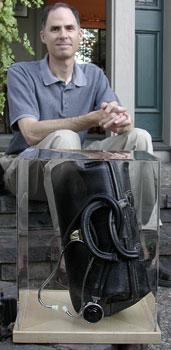|
Maury Schulkin
Physician - - - June 23, 2002 Santa Rosa, CA My stethoscope is the first one that I ever used, purchased in medical school. The choice of stethoscope was a big deal for my classmates and me. We of course had no idea what a heart murmur sounded like, so getting the most sensitive stethoscope was akin to obtaining a powerful amulet that would enable us to hear those faint heart murmurs that our professors assured us were present. This was a top-of-the-line Hewlett-Packard stethoscope with parallel rubber tubing, a large diaphragm for hearing high-pitched murmurs and a state-of-the-art bell for detecting the hard to hear low-pitched murmurs. For the first few years I used my heavy, clunky, but powerful stethoscope. As I entered my residency in family practice it dawned on me that the light weight, compact, convenient and inexpensive stethoscope was a whole lot easier to carry around in my pocket on thirty-six hour shifts. As my clinical skills in medicine were maturing I found I no longer needed to cling to my magic amulet for skill and confidence. It's been years since I've used this stethoscope. Reflecting on my old stethoscope reminds me of an incident when I was a first year family practice resident in Santa Monica, CA. I was taking care of an elderly patient whose family doctor was near the end of his career and seemed to know little about modern medical care. He came into the room to visit his patient while I was present, listened thoughtfully to the heart and lungs with his stethoscope , spoke a few words of support and then moved on with his morning rounds. I smugly stifled a giggle as I noticed that the ear pieces of his stethoscope remained behind his neck the whole time. Now after twenty years of clinical practice I realize that he helped just as much in the healing of that patient by visiting and laying the stethoscope on the chest as I did with my fancy modern medicine. The Doctor's Black Bag was purchased at the same time as the stethoscope. As a beginning medical student we packed every tool that might be needed into this bag as we visited patients on the wards to practice our physical examinations. It soon became apparent that all I really needed I could fit into the pockets of my white coat, and the Black Bag found a home at the back of my bedroom closet. When I later was working as a family physician in Mountain View, CA I found that although the house call had been counted out as a dead tradition, I did indeed have patients who were home bound or those dying from Cancer for whom house calls remained a key part of my practice. The Black Bag was dusted off and accompanied me on all of my house calls. Although the last ten years of my practice have been in the field of emergency medicine, I still recall the visits to comfort a dying patient with my trusty Black Bag as some of the most special memories from my career. In case:
< > |
